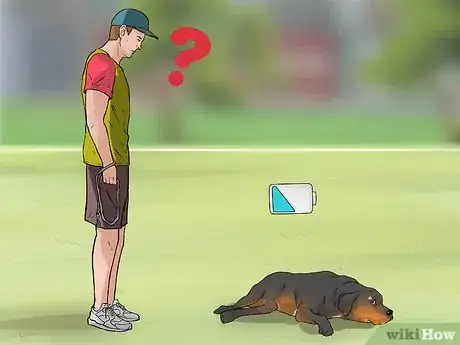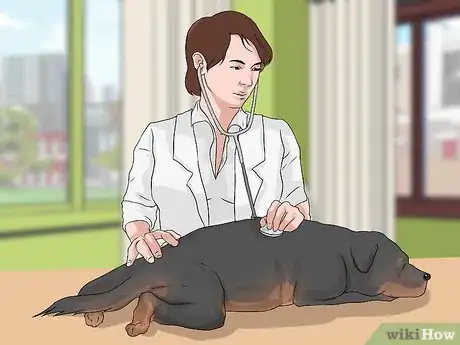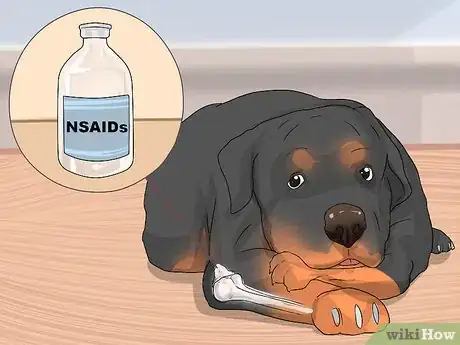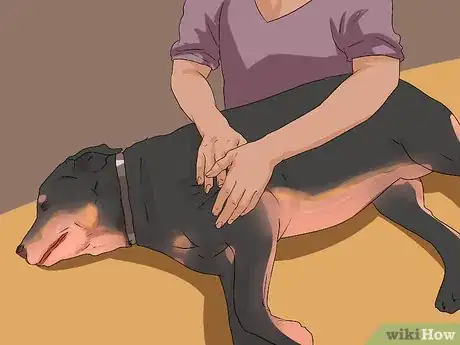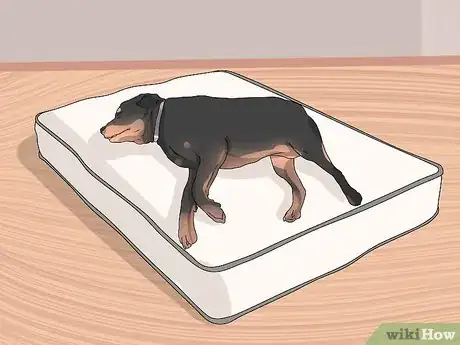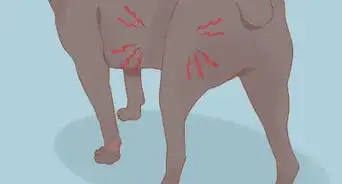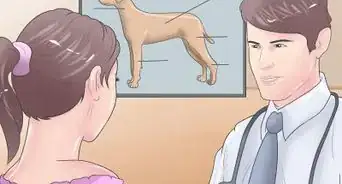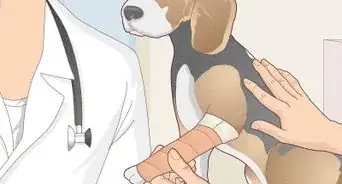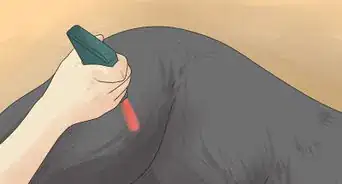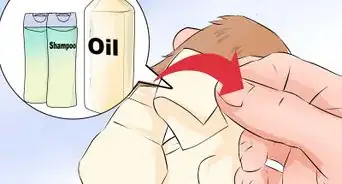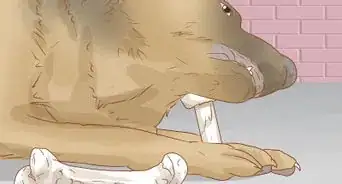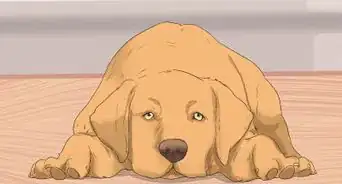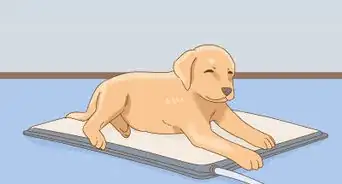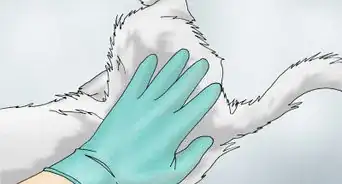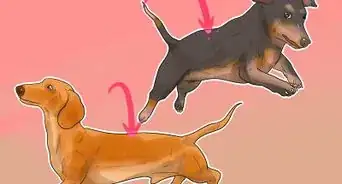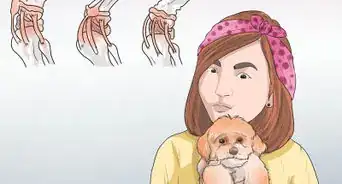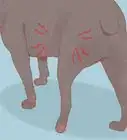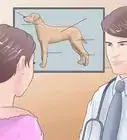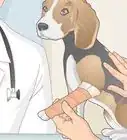This article was co-authored by Pippa Elliott, MRCVS. Dr. Elliott, BVMS, MRCVS is a veterinarian with over 30 years of experience in veterinary surgery and companion animal practice. She graduated from the University of Glasgow in 1987 with a degree in veterinary medicine and surgery. She has worked at the same animal clinic in her hometown for over 20 years.
There are 18 references cited in this article, which can be found at the bottom of the page.
This article has been viewed 34,060 times.
Rottweilers are large and powerful, which makes them well suited for activities requiring endurance and strength. Your own Rottweiler may not have to regularly perform feats of strength, but his large size makes him prone to developing joint problems, particularly elbow or hip dysplasia.[1] Over time, dysplasia can make moving around difficult and painful for your Rottweiler. Although dysplasia has no cure, you can treat your Rottweiler for this condition so he can get the most out of life.
Steps
Identifying Dysplasia in Your Rottweiler
-
1Look for changes in your Rottweiler’s activity level. With dysplasia, your Rottweiler’s joints become painful from normal wear and tear. If your Rottweiler’s joints are bothering him, he’ll start slowing down or completely avoid certain activities. For example, he might be unable to handle long walks and may refuse to go on walks at all.[2] In addition, he may be more reluctant to go up and down stairs.[3]
- If your Rottweiler used to excitedly greet you at the door, he might walk more slowly toward the door, or simply stay where he is.
-
2Observe how your Rottweiler walks. Rottweilers with hip dysplasia have a characteristic ‘bunny hop’ gait, during which the back legs move at the same time, rather than one at a time.[4] With elbow dysplasia, your Rottweiler may have a ‘paddling’ gait (legs swinging out to the side) if both front legs are painful.[5] Limping is common with either form of dysplasia.Advertisement
-
3Watch how your Rottweiler holds his front legs. Elbow dysplasia occurs when the radius and ulna (the two bones below the elbow) grow at uneven rates in the front legs. This unevenness causes the bones to fit improperly into the elbow joint, creating pressure and pain. Your Rottweiler will try to relieve this discomfort by twisting the affected leg out to one side. Unfortunately, twisting the leg out worsens the dysplasia.[8]
-
4Take your Rottweiler to your vet. Your vet will perform a full physical exam, then perform a more focused orthopedic exam. During the orthopedic exam, your vet will move your Rottweiler’s legs and joints in different directions, as well as watch how your Rottweiler walks (and runs, if possible).
- X-rays will help your vet see how much your Rottweiler’s joints have been affected by the dysplasia. Since your Rottweiler may be in a lot of pain, he will need to be sedated for the x-rays.[9]
- On an x-ray for hip dysplasia, the top of the femur (thigh bone) does not fit into the hip socket and may have extra bone growth. For elbow dysplasia, your vet would see bone fragments in the joint.[10]
- Realize that joint degeneration and pain do not always go together. For example, a painful dog that can’t walk very well may have only mild joint degeneration.[11]
Implementing Non-Surgical Treatments
-
1Modify your Rottweiler’s exercise. Dysplasia treatment is divided into medical (non-surgical) and surgical. Controlled exercise is an effective form of medical treatment since it can maintain muscle tone, improve joint stability, and improve range of motion. Short walks and swimming are great low-impact exercises for your Rottweiler. How much exercise he can handle will involve some trial and error.[12]
-
2Manage your Rottweiler’s weight. Large dogs put more pressure on their joints. Rottweiler’s are naturally large dogs, so if your Rottweiler is carrying around extra weight, he’s putting even more pressure on his joints. Help him lose weight by switching him to a reduced-calorie diet, which you can purchase through your vet or at your local pet store.
- If you’ve been feeding him store-bought treats, which tend to be high in fat, switch him to healthy treats or take treats out of his diet entirely. Carrot sticks and orange slices are healthy treats.[16]
- Daily exercise will help your Rottweiler lose weight.
- Weight loss in dogs should be gradual. Your vet can determine your Rottweiler’s ideal weight and how long it should take him to reach that weight.
-
3Add supplements to your Rottweiler’s diet. Dietary supplements called nutraceuticals have become increasingly popular for treating joint problems in dogs.[17] Nutraceuticals containing chondroitin and/or glucosamine, which are effective at repairing damaged joint cartilage, are commonly used in dogs.[18]
- Omega-3 fatty acids help improve joint health.[19]
- Many nutraceuticals are available, but not all of them are high in quality. Ask your vet to recommend high-quality products for your Rottweiler.
-
4Use medication to reduce joint pain and inflammation. Non-steroidal anti-inflammatory drugs (NSAIDs) are commonly used to reduce joint pain and inflammation in dogs. Always have your dog take non-steroidals with or after eating food, as they can cause side effects like stomach ulcers when given on an empty stomach. Your vet may check your dogs liver and kidney function before starting medication to make sure it won't have any serious side effects. While your Rottweiler is on NSAIDs, your vet will run blood tests to check his liver and kidney function.[20]
- Tramadol relieves pain and doesn’t have many side effects. Steroids reduce pain and inflammation but can cause serious side effects, such as weight gain and weakened bones.[21]
- Whichever medication your vet prescribes, follow the prescription instructions carefully.
-
5Perform physical therapy and massage. Physical therapy and massage are effective at improving muscle tone and enhancing blood flow in joints.[22] [23] Your vet can recommend various physical therapy exercises for you to perform on your Rottweiler at home.
- A massage can feel like a little piece of heaven to your Rottweiler. Make the massage area quiet and comfortable. When you massage him, use gentle pressure around his joints.[24]
- It may take a while for your Rottweiler to get used to the massage. Be patient as he gets accustomed to you touching him in this way.
-
6Keep your Rottweiler’s sleeping area comfortable. Your Rottweiler will appreciate a warm and comfortable place to sleep if he has dysplasia. Consider purchasing an orthopedic foam bed, which will be easy for him to get into and out of and will not create painful pressure points around his joints. Place the bed in a warm and draft-free area of your home.[25]
- When your Rottweiler is not in his bed, you could use heating pads around his joints to warm him up and relieve pain. Wrap the heating pad in a towel to prevent his skin burns.[26] Limit the use of the heating pad to 15 or 20 minutes.
Using Surgery to Treat Dysplasia
-
1Discuss surgical options with your vet. Surgery is frequently recommended for elbow dysplasia. The main goals for elbow dysplasia surgery are to correct unevenness between the radius and ulna and repair joint damage.[27] Several different types of elbow dysplasia surgery are available, including total elbow replacement.[28]
- Several surgical options also exist for hip dysplasia, including total hip replacement or removal of the head (top) of the femur.[29]
- Your vet will be able to recommend the ideal surgery for your Rottweiler.
- Obese dogs typically do not make good candidates for surgery.[30] If your Rottweiler is obese, your vet may recommend that he lose a certain amount of weight before having surgery.
- Depending on the complexity of the surgical procedure, your vet may refer you to a veterinary surgeon.
-
2Consider the risks of surgery. Surgery may be the best option for your Rottweiler’s dysplasia, but it is not risk-free. For example, surgery to remove the head of the femur can result in decreased range of motion and loss of muscle mass.[31] Potential complications of a total hip replacement are hip dislocation and nerve injury.[32]
- With total elbow replacement, there is a risk of the surgical plate or screws breaking or dislocating.[33]
- Your Rottweiler may or may not develop complications after surgery. However, it is good to understand the risks before moving forward with surgical treatment.
-
3Care for your Rottweiler after surgery. When you take your Rottweiler home after surgery, you will need to restrict his exercise and keep him away from stairs and slippery surfaces. Do not allow him to play with other dogs.[34] In addition, you should perform the recommended physical therapy exercises and engage in low-impact exercises (e.g., short walks).[35]
- Your vet will prescribe pain medications for your Rottweiler after surgery.
- Your vet will want to see your Rottweiler after surgery to take out his sutures (if necessary) and assess the improvement of the dysplasia.
Warnings
- Untreated dysplasia can negatively affect your Rottweiler’s quality of life.⧼thumbs_response⧽
- Medical treatment of elbow dysplasia is not very effective at stopping painful bony changes in your Rottweiler’s elbow joints.[42] Surgery is usually the better choice for elbow dysplasia treatment.⧼thumbs_response⧽
- Unethical breeding practices increase the likelihood of severe hip dysplasia in Rottweilers.⧼thumbs_response⧽
References
- ↑ http://www.petmd.com/dog/breeds/c_dg_rottweiler#
- ↑ https://www.acvs.org/small-animal/canine-elbow-dysplasia
- ↑ http://www.2ndchance.info/hipdysplasiadog.htm
- ↑ http://www.peteducation.com/article.cfm?c=2+2084&aid=444
- ↑ http://www.fitzpatrickreferrals.co.uk/orthopaedic/canine-elbow-dysplasia/
- ↑ http://www.2ndchance.info/hipdysplasiadog.htm
- ↑ http://www.petmd.com/dog/conditions/musculoskeletal/c_dg_elbow_dysplasia#
- ↑ http://www.limpingrottweiler.com/index.htm
- ↑ http://www.2ndchance.info/hipdysplasiadog.htm
- ↑ https://www.acvs.org/small-animal/canine-elbow-dysplasia
- ↑ http://www.vcahospitals.com/main/pet-health-information/article/animal-health/hip-dysplasia-in-dogs/783
- ↑ https://www.ofa.org/diseases/hip-dysplasia#treatmentoptions
- ↑ http://www.2ndchance.info/hipdysplasiadog.htm
- ↑ http://www.vcahospitals.com/main/pet-health-information/article/animal-health/hip-dysplasia-in-dogs/783
- ↑ http://www.peteducation.com/article.cfm?c=2+2084&aid=444
- ↑ http://www.canismajor.com/dog/obese.html
- ↑ http://www.petmd.com/dog/general-health/evr_dg_arthritis_how_to_recognize_and_manage_the_condition?page=show#
- ↑ http://www.akcchf.org/canine-health/your-dogs-health/caring-for-your-dog/managing-canine-arthritis.html
- ↑ http://www.vcahospitals.com/main/pet-health-information/article/animal-health/hip-dysplasia-in-dogs/783
- ↑ http://www.akcchf.org/canine-health/your-dogs-health/caring-for-your-dog/managing-canine-arthritis.html
- ↑ http://www.2ndchance.info/hipdysplasiadog.htm
- ↑ http://www.peteducation.com/article.cfm?c=2+2084&aid=231
- ↑ http://www.akcchf.org/canine-health/your-dogs-health/caring-for-your-dog/managing-canine-arthritis.html
- ↑ http://moderndogmagazine.com/articles/how-massage-your-dog/2028
- ↑ http://www.peteducation.com/article.cfm?c=2+2084&aid=444
- ↑ https://www.ofa.org/diseases/hip-dysplasia#treatmentoptions
- ↑ https://www.acvs.org/small-animal/canine-elbow-dysplasia
- ↑ http://www.fitzpatrickreferrals.co.uk/orthopaedic/canine-elbow-dysplasia/
- ↑ http://www.peteducation.com/article.cfm?c=2+2084&aid=444
- ↑ https://www.ofa.org/diseases/hip-dysplasia#treatmentoptions
- ↑ http://www.topdoghealth.com/library/orthopedic-surgery/articles-surgery/femoral-head-osteotomy-fho-dogs/#five
- ↑ https://www.acvs.org/small-animal/canine-hip-dysplasia
- ↑ http://www.willows.uk.net/specialist-services/pet-health-information/orthopaedics/elbow-dysplasia
- ↑ https://www.acvs.org/small-animal/canine-hip-dysplasia
- ↑ https://www.ofa.org/diseases/hip-dysplasia#treatmentoptions
- ↑ http://www.peteducation.com/article.cfm?c=2+2084&aid=444
- ↑ http://www.limpingrottweiler.com/index.htm
- ↑ http://www.petmd.com/dog/conditions/musculoskeletal/c_dg_elbow_dysplasia?page=show
- ↑ http://www.2ndchance.info/hipdysplasiadog.htm
- ↑ http://www.peteducation.com/article.cfm?c=2+2084&aid=444
- ↑ http://www.2ndchance.info/hipdysplasiadog.htm
- ↑ http://www.fitzpatrickreferrals.co.uk/orthopaedic/canine-elbow-dysplasia/
About This Article
To treat dysplasia in your Rottweiler, take it to your vet for a physical exam if you spot common symptoms, like decreased activity levels or a walk that looks like a bunny hop. After your vet confirms the diagnosis, make sure your dog gets regular low impact exercise, like short walks and swimming, which are important for maintaining muscle tone and strengthening joints. You should also manage your Rottweiler’s weight by watching what it eats, since its joints will be under more pressure if it’s overweight. If your dog has elbow dysplasia, ask your vet about surgical options, such as total elbow replacement. However, bear in mind that surgery can sometimes have negative effects, including a decrease in motion or loss of muscle. For tips from our Veterinary co-author, including how to care for your Rottweiler after surgery, keep reading!
